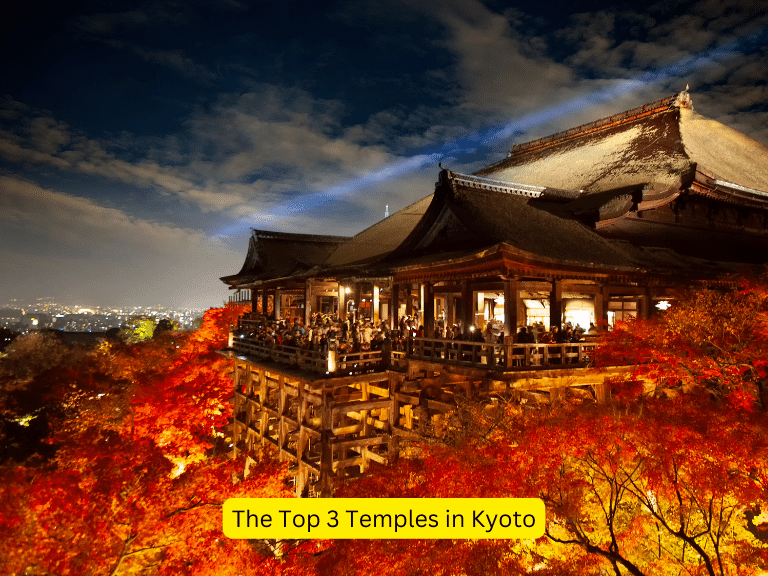Kyoto Temple Japan: A Journey Through Japan’s Spiritual Heart
Discover the Mystical Beauty of Kyoto Temple Japan and Shrines
Kyoto, the ancient capital of Japan, is a city that embodies the very essence of Japanese culture and spirituality. Kyoto temple japan With its serene gardens, traditional tea houses, and, most notably, its stunning temples and shrines, Japan invites visitors to step into a world where history and spirituality converge. This article ventures into the heart of Kyoto’s religious architecture, exploring the intricacies of its temples and shrines.
By offering a glimpse into the Kyoto temples and shrines map, highlighting the most beautiful temple in Kyoto, and answering key questions about these sacred sites, we aim to provide an in-depth understanding of Kyoto’s spiritual landscape. Whether you’re a history buff, a spiritual seeker, or simply in love with Japanese culture, this article will guide you through the wonders of Kyoto’s temples, making it an essential read for anyone planning to visit or fascinated by this iconic city.
Exploring Japanese Temples Kyoto’s and Shrines Map

Temples in Kyoto
Kyoto, with its intricate network of spiritual sites, boasts over 1,600 Buddhist temples and numerous Shinto shrines. This rich tapestry of sacred spaces forms a complex map that invites exploration. Each temple and shrine tells a story, set against the backdrop of Kyoto’s lush landscapes and historical narratives. Understanding this map is not just about locating these sites but about connecting with the historical and cultural context that each location embodies.
Imagine stepping into a world where time stands still, amidst the serene beauty of ancient temples and shrines, each telling a tale as old as time itself. Welcome to Japanese Temples Kyoto, a city where the past and present coalesce in a harmonious symphony, beckoning travelers from across the globe to explore its sacred secrets. This journey isn’t just about visiting places; it’s about unraveling the rich tapestry of history, culture, and spirituality that Kyoto embodies.
As you navigate through the city’s labyrinth of narrow lanes, a meticulously curated map in hand, you embark on an adventure that promises to be nothing short of transformative. The shrines, with their torii gates casting long shadows in the setting sun, and the temples, echoing the silent prayers of centuries, invite you to pause and reflect. This exploration is not merely a tour; it’s a pilgrimage of the soul, seeking the essence of beauty and tranquility in the heart of Japan.
Let your curiosity be your guide as you delve into the mystique of Kyoto’s sacred sites, each stop on your map a doorway to the past and a bridge to inner peace. Are you ready to embark on this journey of discovery and enchantment?
The Most Beautiful Temple in Kyoto: A Visual Feast

Temples in Kyoto
Among the plethora of temples, there stands one that is often hailed as the most beautiful in Kyoto. While beauty is subjective, certain temples captivate visitors with their architectural magnificence, tranquil gardens, and the sense of peace they evoke. These temples serve as a testament to the artistic and spiritual achievements of Japan’s past.
In the heart of Japan lies Kyoto, a city where beauty transcends the mere visual, weaving into the spiritual and historical fabric of the place. Among its many jewels, one temple stands as a pinnacle of aesthetic and architectural splendor, captivating the hearts of all who wander its sacred grounds.
This temple, a symphony of meticulous garden designs, intricate woodwork, and sublime gold leaf accents, offers a visual feast that transcends time. Its charm lies not only in its breathtaking beauty but also in the profound sense of peace it bestows upon its visitors. As you step through its ancient gates, you are transported into a world where every detail tells a story of devotion, artistry, and the pursuit of perfection.
This is not just a visit; it’s an immersion into a realm where nature and human craftsmanship converge to create a masterpiece of cultural heritage. Ready to embark on a journey to discover the most beautiful temple in Kyoto? Let’s unveil the secrets of this iconic sanctuary, where every view is a painting and every moment a cherished memory.
The Sacred Count: How Many Temples in Kyoto?
Temples in Kyoto
The sheer number of temples in Kyoto is a reflection of the city’s deep spiritual roots. Each temple offers a unique glimpse into the different aspects of Buddhist practice and belief, from Zen gardens that inspire meditation to halls adorned with intricate art depicting the teachings of Buddha. This diversity not only showcases the rich tapestry of Buddhism in Japan but also Kyoto’s role as a guardian of these traditions.
Kyoto, a city enveloped in the whispers of history and the serenity of spiritual sanctuaries, holds within its bounds an astonishing mosaic of temples and shrines, each a beacon of tranquility and cultural legacy. But just how many of these sacred sites dot the landscape of this ancient capital? The number might astonish you: Kyoto is home to over 1,600 temples, a testament to its enduring significance as the heart of Japanese Buddhism and Shinto practices.
This sacred count includes a spectrum from Zen gardens of contemplation to halls dedicated to myriad deities, offering a labyrinth of spiritual exploration. These temples serve not merely as places of worship but as custodians of art, history, and architecture, inviting both pilgrims and curious minds into a world where the divine intersects with the earthly. Embarking on a quest to discover each one, you’re not just counting structures; you’re weaving through a tapestry of stories that span centuries, each temple a chapter in Kyoto’s profound narrative.
Ready to explore the depth and diversity of Kyoto’s spiritual heritage? Let this be the starting point of a journey into the heart of Japan’s religious soul, where every temple holds a new revelation.
The Iconic Kyoto Temple with Red Gates

Temples in Kyoto
One of Kyoto’s most iconic images is that of the Fushimi Inari Shrine, famous for its thousands of vermilion torii gates that trail through the woods. While technically a Shinto shrine, it exemplifies the seamless blend of religious practices in Japan and is a must-visit for anyone seeking to immerse themselves in the spiritual ambiance of Kyoto.
Nestled amidst the verdant embrace of Kyoto’s serene landscape lies a vision that captures both the eye and the soul—the iconic Kyoto Temple, renowned for its mesmerizing red gates that guide pilgrims and wanderers alike through a journey of spiritual and aesthetic awakening.
This architectural marvel, a symphony of tradition and tranquility, stands as a testament to the timeless allure of Japanese heritage, inviting the world to step through its gates into a realm where history whispers through the rustling leaves and spirituality permeates the air.
As you embark on this enchanting voyage through the heart of Kyoto, prepare to be captivated by the allure of ancient customs, the beauty of meticulous garden landscapes, and the profound peace that dwells within these sacred precincts. Join us as we explore the depths of its history, the symbolism of its red gates, and the indelible mark it leaves on every soul fortunate enough to wander its paths.
The Top 3 Temples in Kyoto: A Spiritual Trilogy

Temples in Kyoto
Identifying the top 3 temples in Kyoto is a challenge, given the city’s abundance of noteworthy sites. However, certain temples stand out for their historical significance, architectural beauty, and spiritual atmosphere. These temples are not just places of worship but are pivotal to understanding Kyoto’s cultural and religious landscape.
In the heart of Japan, Kyoto stands as a bastion of culture and spirituality, offering a mosaic of serene landscapes dotted with temples that whisper tales of the past to those who wander through their sacred halls. Among these bastions of tranquility, three temples shine as jewels in the city’s illustrious crown, beckoning travelers from across the globe to bask in their historical splendor and architectural magnificence.
First, the Kinkaku-ji, or the Golden Pavilion, dazzles under the sun, its golden reflection shimmering across the tranquil pond, embodying the extravagant yet profound aesthetic of Muromachi period architecture.
Then, there’s the Fushimi Inari-taisha, renowned for its endless arcade of vermilion torii gates, which weave through the mountainous landscape, creating a mesmerizing path that leads to spiritual discovery.
Lastly, the Kiyomizu-dera, perched on the hillside, offers breathtaking views of the city below, its wooden stage a testament to the ingenuity of Edo period craftsmanship, sans a single nail in its construction. Embark on a journey through these sacred sites and immerse yourself in the profound peace and beauty that define Kyoto’s spiritual landscape.
Paying Homage to the Famous Temples in Kyoto

Temples in Kyoto
Kyoto’s famous temples, such as Kinkaku-ji (the Golden Pavilion), Ginkaku-ji (the Silver Pavilion), and Kiyomizu-dera, are celebrated for their breathtaking beauty and historical importance. These temples are emblematic of Kyoto’s spiritual heritage and offer insights into the evolution of Japanese architecture and garden design.
In the heart of Japan, nestled among verdant hills and whispering waters, lies Kyoto—a city that pays homage to the divine and the historical with an elegance unmatched anywhere else in the world. Imagine stepping into a realm where Kinkaku-ji (the Golden Pavilion) glimmers under the sun, Ginkaku-ji (the Silver Pavilion) reflects the moonlight, and Kiyomizu-dera stands as a testament to architectural ingenuity and spiritual perseverance.
These famous temples are not just structures; they are a symphony of beauty, history, and tranquility that captures the essence of Kyoto’s spiritual heritage. Each corner of these sacred sites offers a unique perspective on the evolution of Japanese architecture and garden design, inviting visitors to embark on a journey through time. The allure of these temples goes beyond their aesthetic appeal; they are keepers of stories, of epochs that whisper tales of devotion and artistry.
As you wander through their ancient corridors, you are not merely a spectator; you are a part of a continuing legacy. This is your invitation to explore the heart of Kyoto, to immerse yourself in the serene beauty of its temples, and to discover the rich tapestry of culture and nature interwoven through centuries.
Unveiling the Main Temples in Kyoto

Temples in Kyoto
The main temples of Kyoto, each with its unique charm and history, are central to the city’s identity. From the tranquil Ryoan-ji with its famous rock garden to the imposing structure of Sanjusangen-do, home to 1,001 statues of Kannon, the Buddhist goddess of mercy, these temples offer a profound experience to visitors.
Embark on a mesmerizing journey to the heart of Japan’s cultural zenith, Kyoto, where ancient temples stand as serene guardians of history and spirituality. Imagine wandering through verdant gardens, each step taking you closer to understanding the profound tranquility that these sacred sites exude.
Kyoto is not just a city; it’s a gateway to exploring the sublime, where the main temples offer not just a visual feast but a deep connection to the spiritual tapestry that Japan is woven from. These temples, each with a story to tell, beckon travelers and seekers alike to delve into their rich heritage, architecture, and the unparalleled peace they offer. Whether it’s the golden reflections of Kinkaku-ji or the thousand gates of Fushimi Inari-taisha, Kyoto’s temples serve as a testament to the city’s ability to preserve its soul amidst the relentless march of time.
Your curiosity piqued, your senses awakened, and a desire kindled to experience these bastions of serenity firsthand. Take action; plan your pilgrimage to Kyoto and let your spirit soar amidst the beauty and tranquility of its most revered temples. Embark on this journey not just as a tourist, but as a pilgrim seeking the ethereal and the eternal in the heart of Japan.
Accessibility of Kyoto’s Temples: Are They Free?

Temples in Kyoto
While many of Kyoto’s temples require an entrance fee, this contribution goes towards the maintenance and preservation of these historic sites. Some temples offer free access to their grounds, allowing visitors to appreciate the exterior architecture and gardens.
Kyoto, a city that resonates with the echoes of Japan’s imperial past, is a tapestry of living history, especially evident in its temples. These sanctuaries, set against a backdrop of lush mountains and vibrant seasons, are not just architectural marvels but the soul of Kyoto’s cultural landscape.
As you plan your pilgrimage to these revered sites, a question arises: Accessibility. Are these temples, which have stood the test of time, welcoming to all through their ancient gates without a fee? The allure of exploring Kyoto’s temples lies not just in their visual splendor but in their ability to transport visitors to a bygone era, making one ponder the balance between preservation and public access.
This inquiry opens the door to a deeper exploration of Kyoto’s spiritual heritage, inviting both the eager traveler and the curious mind to delve into the heart of traditional Japan. The desire to tread upon these hallowed grounds, to experience the tranquility and the spiritual resonance of places like Kinkaku-ji, Fushimi Inari-taisha, and Ginkaku-ji, is palpable.
Let’s embark on a journey to uncover the mysteries of Kyoto’s temples: their accessibility, the stories they tell, and whether the serene beauty of these spaces is freely available to those who seek it.
Discovering the Largest Temple in Kyoto

Temples in Kyoto
The largest temple in Kyoto, Tofuku-ji, is renowned for its vast temple grounds and its spectacular autumn foliage. The scale of Tofuku-ji offers a glimpse into the grandeur of religious architecture in Japan and the importance of temples as centers for cultural and spiritual gatherings.
In the heart of Japan, nestled among verdant landscapes and whispering streams, lies Kyoto – a city that is a testament to the enduring legacy of Japanese culture. Among its many treasures, one stands out not just for its spiritual significance but for its sheer magnitude: the largest temple in Kyoto.
This colossal sanctuary is more than just a place of worship; it’s a journey into the soul of Japanese heritage, a beacon of architectural grandeur that has captivated both pilgrims and travelers for centuries. The very mention of this temple evokes a sense of awe, stirring a desire to traverse its expansive grounds, to wander through its hallowed halls, and to lose oneself in the intricate tapestry of its history.
This temple, a marvel of both scale and beauty, invites those with a thirst for discovery to delve into its depths, to uncover the stories etched into its walls, and to experience the profound tranquility that pervades its atmosphere. As we embark on this journey to discover the largest temple in Kyoto, we are not just exploring a physical structure, but entering a realm where history, culture, and spirituality converge, offering a unique glimpse into the heart of Japan.
The Most Famous Shinto Shrine in Kyoto

Temples in Kyoto
Fushimi Inari Taisha, with its endless arcades of torii gates, is not only Kyoto’s most famous Shinto shrine but also a symbol of Japan’s indigenous spirituality. Dedicated to Inari, the Shinto god of rice and prosperity, this shrine attracts millions of visitors, drawn by its unique beauty and spiritual significance.
In the heart of Kyoto, where ancient traditions echo through the bustling modern streets, lies the most famous Shinto shrine of the city: Fushimi Inari-taisha. This shrine, a pinnacle of spiritual significance, not only captivates the hearts of those who walk its sacred paths but also stands as a testament to the enduring legacy of Shintoism in Japan.
Known for its thousands of vermilion torii gates, which trail into the wooded forest of the sacred Mount Inari, Fushimi Inari-taisha offers a journey through a tunnel of vibrant color that symbolizes the transition from the mundane to the sacred. This iconic site draws visitors not just for its breathtaking visuals but for its deep spiritual significance, embodying the essence of Kyoto’s religious heritage.
The shrine is dedicated to Inari, the Shinto god of rice, agriculture, and prosperity, reflecting the intertwined nature of faith and daily life in Japanese culture. As you embark on the winding paths up the mountain, each gate, donated by individuals and businesses hoping for prosperity, tells a story of devotion and hope. Fushimi Inari-taisha is not just a destination; it’s an experience, inviting exploration, reflection, and a connection to the spiritual world that thrives amidst the temporal.
Temples in Kyoto
In conclusion, Kyoto’s temples and shrines are much more than mere tourist attractions; they are the soul of the city, embodying centuries of history, culture, and spirituality. Exploring these sites offers a unique window into the heart of Japanese tradition and provides a serene escape from the hustle and bustle of modern life. As we journey through these sacred spaces, we’re reminded of the beauty of simplicity, the importance of nature, and the profound depth of human spirituality.
FAQs
1. What is the best time of year to visit Kyoto’s temples?
The best time to visit Kyoto’s temples is either during the cherry blossom season in spring (late March to early April) or in the fall (late November to early December) when the autumn colors are at their peak. Both seasons offer a stunning backdrop to the temples’ architectural beauty.
2. Can you participate in Zen meditation sessions at Kyoto temples?
Yes, several temples in Kyoto offer Zen meditation sessions for visitors, including beginners. These sessions are a unique opportunity to experience Zen practices firsthand and to deepen your understanding of Buddhist philosophy.
3. Are photography and videography allowed in Kyoto’s temples?
Photography and videography rules vary by temple. While some temples allow photography in their grounds, others may restrict it, especially inside the buildings. Always look for signage or ask staff for guidance to respect the sanctity of these spiritual sites.







